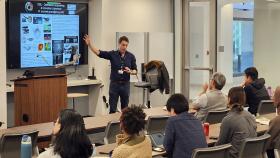
At the intersection of ophthalmology, engineering, and artificial intelligence
The approach we take
Since establishing the Ophthalmic Engineering & Innovation Laboratory (OEIL) in Singapore in 2012, Michaël J.A. Girard, PhD has stragegically leveraged the remarkable growth in engineering and ophthalmology to advance translational research.
Now partnered with the Emory department of Ophthalmology, and the GTech/Emory department of Biomedical Engineering, Dr. Girard and OEIL are positioned to maximize imputs from artificial intelligence (AI) and physics - particularly biomechanics - to advance translational research in ophthalmology. This multidisciplinary approach holds the key to unlocking a deeper understanding of a wide range of ophthalmic disorders and developing innovative treatments. Additionally, our work aims to enhance and simplify the screening, diagnosis, and prognosis of these conditions.
Dr. Girard's research is particularly concentrated on optic neuropathies, including glaucoma, but also extends to myopia, neuro-ophthalmic, and neurological disorders. With a strong emphasis on translational research, OEIL maintains close collaborations with clinicians and industry partners—a relationship that is poised to expand in the near future.
The problems we tackle
Dr. Girard and the OEIL group are committed to developing explainable AI algorithms integrated with 3D digital twin models (biofluid and biosolid) to uncover the mechanisms of axonal injury in patients with optic neuropathies, including glaucoma. This approach aims to deepen our understanding of why some individuals lose vision despite existing treatments. Dr. Girard and his team seek to comprehensively assess the in-vivo biomechanics, blood perfusion, and intricate 3D architecture of retinal and optic nerve head (ONH) cells and tissues—the primary sites of injury in these conditions.
The OEIL group's ultimate goal is to create a foundation model for the optic nerve head that can identify novel cellular, vascular, and connective tissue markers, redefine optic neuropathies from an engineering perspective, and drive the development of innovative treatment strategies.
Working with Dr. Girard, OEIL researchers have access to
- State-of-the-art optical coherence tomography (OCT) technology to image patients with optic neuropathies at Emory
- Excellent AI resources
- A large retrospective OCT database from Emory (n>200,000)
- A wide international network of world-renowned clinical collaborators from USA, Europe, Asia, Africa, and Australia that can provide further imaging data, as fostered by the PI over the past 20 years
- Strong links with industry and our experience at spinning off or licensing technologies;
- Support and career advice.
Researcher Michaël Girard delivers eye-popping presentation at BME Seminar Series


